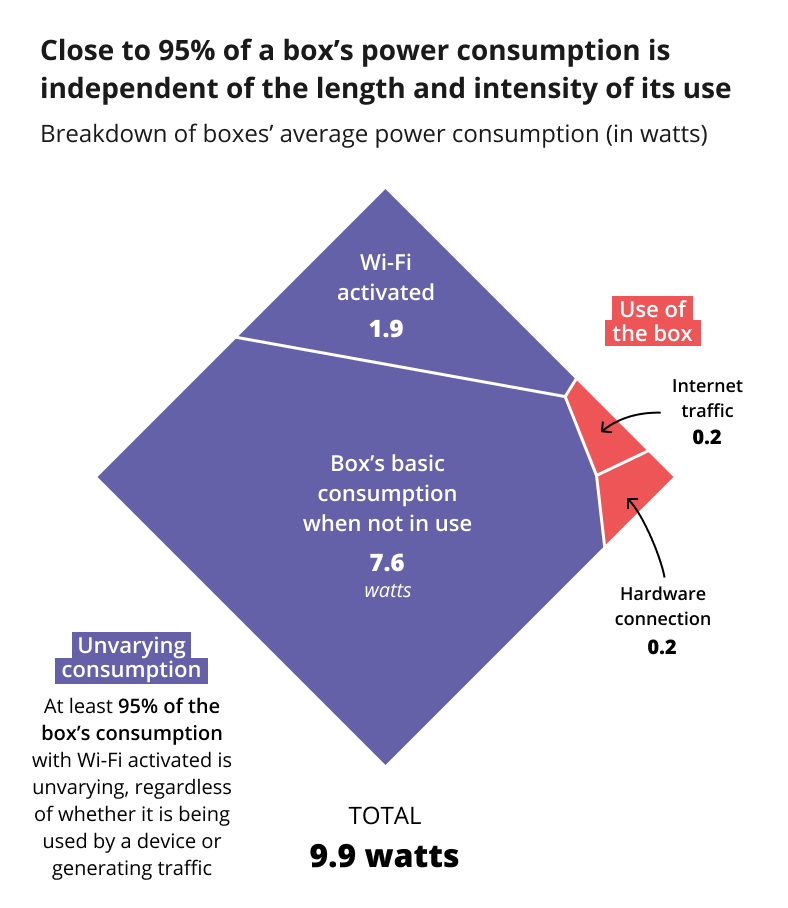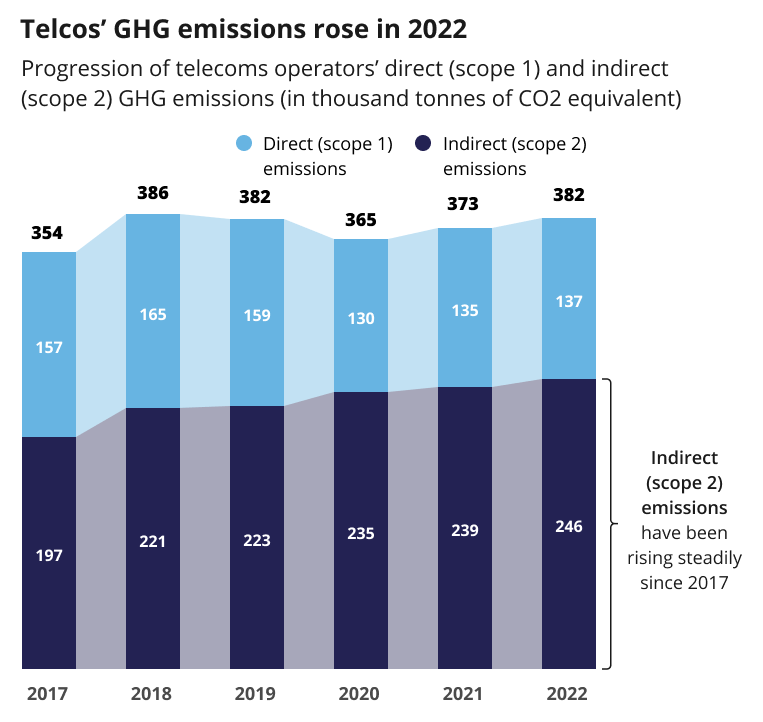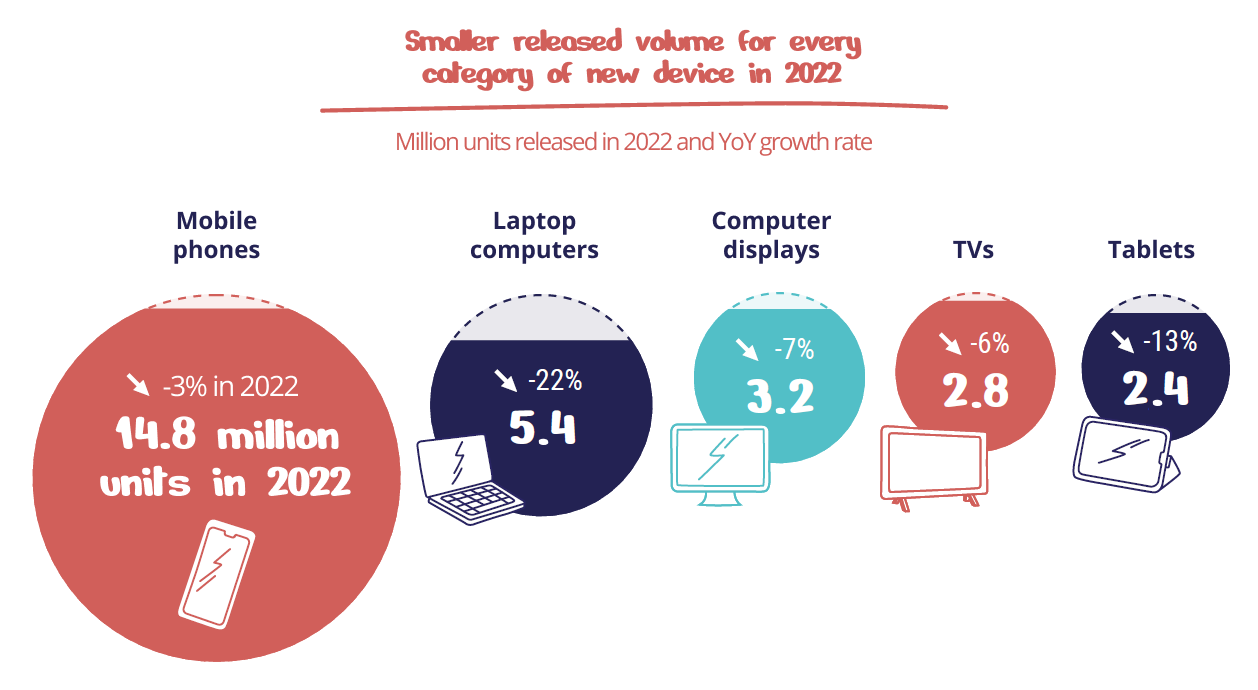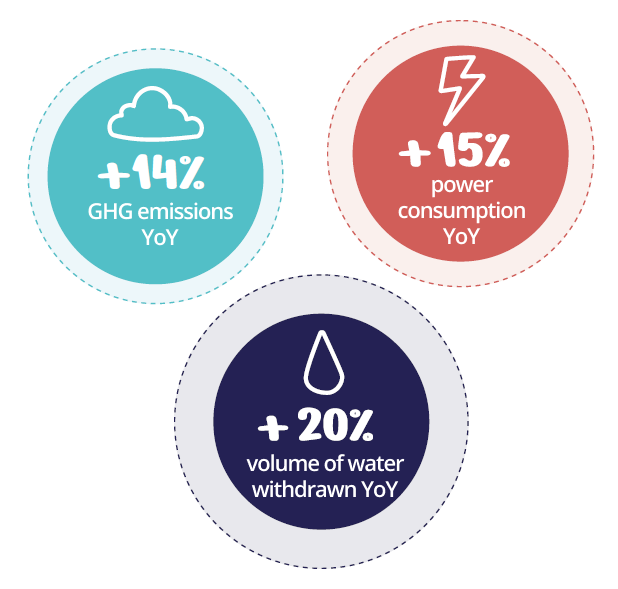To track information and communication technologies’ impact on the environment, Arcep has been collecting indicators from France’s four main telecoms operators since 2020, and delivering its findings in an annual publication: its “achieving digital sustainability” inquiry, along with an infographics-based summary. This third edition has been expanded to include indicators on two new stakeholder categories: data centre operators and device manufacturers.
Massively energy hungry internet and set-top boxes: their annual power consumption represents 0.7% of total power consumption in France in 2022 and is three times that of fixed networks*.
In 2022 in France, internet and set-top boxes together consumed 3.3 TWh, or three times the amount of electricity consumed by fixed networks. Consumption levels varied considerably amongst the 38 models of internet boxes (aka routers) and 23 models of STBs that were studied, but depended very little on how much the devices were used or how much data traffic they generated: 95% of their consumption does not vary, regardless of whether the box is being solicited by the user.
There is therefore room to reduce these devices’ power consumption, thanks to sustainable design and the development of features that make it possible to put internet and set-top boxes into deep sleep mode automatically.
*by definition, fixed networks here include all of an operator’s equipment used to provide telephone services or internet access over a wireline connection, up to the operator’s network termination point in the customer’s premises.
Telecoms operators’ greenhouse gas emissions and networks’ power consumption is increasing, driven by growing use
At a time when greenhouse gas emissions in France are decreasing by 2.7% YoY, the country’s four main electronic communications operators’ emissions increased by 2% for the second year in a row, to reach 382,000 tonnes of CO2 equivalent in 2022.
With the increase in mobile data traffic and ongoing mobile network rollouts, mobile networks’ energy consumption grew substantially in in 2022: its rate of increase more than doubled between 2021 and 2022 (+ 14% in 2022 vs. + 6% in 2021). Meanwhile, fixed networks’ power consumption decreased by 14% YoY, in particular due to the ongoing transition from copper to the far more energy-efficient optical fibre. This decrease is not, however, enough to offset mobile networks’ increasing energy consumption.
As a result, fixed and mobile networks’ power consumption[1] rose by 7% in 2022 to reach 4.1 TWh, whereas overall power consumption in France decreased by 4%, as the energy crisis continued.
Very small percentage of operators’ handset sales are refurbished phones
Mobile phone sales decreased in 2022, both in the French retail market and for telecoms operators. Operators’ refurbished handset sales decreased dramatically, however (- 9% in 2022 versus + 11% one year earlier) while continuing to increase in the market as a whole. They continue to represent only a small fraction of operators’ handset sales: 4%, compared to 25% on all other sales channels.
Laptop computers, computer displays, tablets, smartphones and televisions: the volume of digital devices being put on the market is decreasing, but screen sizes are increasing
This decreased volume of devices being put on the market is in part situational: for laptop computers, computer displays and tablets, whose sales increased significantly with the rise of remote working. For smartphones and televisions, this downwards trend has been ongoing for several years.
The smaller number of devices released onto the market in 2022 should help reduce device manufacturers’ carbon footprint. But this decrease could be counterbalanced by devices’ increasingly large screens, which have a larger footprint. The inquiry revealed that the proportion of digital devices with large displays is increasing for virtually every type of device.
Data centre operators’[2] greenhouse gas emissions and energy and water consumption increased by more than 10% in 2022
As the use of digital technology continues to grow, and with the increased outsourcing of IT services, there was a rise in 2021 and 2022 in the number of new data centres that analysed data centre operators began operating, and these players’ greenhouse gas emissions reached 95,000 tonnes eq. CO2 in 2022, which marks a 14% increase YoY.
This increase can be attributed to the sizeable rise in indirect emissions tied to energy consumption, which represent more than 90% of data centre operators’ total emissions: their energy consumption stood at 2.1 TWh in 2022 and increased by 15% YoY, compared to unchanged consumption levels in 2022 for the tertiary sector (which owns the data centres). Some data centres are nevertheless more energy efficient than others: on average, the newest ones and those with large computing capacity are the most energy efficient.
With global warming, monitoring the withdrawals of water, which can become a scarce resource in times of drought, becomes vital. The volume of water withdrawn by data centre operators totalled 482,000 m3 in 2022, a level that remains modest (only 0.02% of all water withdrawn for economic activities in 2021) compared to the volumes employed for economic activities’ other uses. This volume did nonetheless increase by 20% YoY in 2022, thereby underscoring how important it will be to monitor this indicator over the coming years.
Next year’s edition of the “achieving digital sustainability” inquiry will be expanded to include new indicators and data collected from mobile network equipment suppliers
As part of its commitment to steadily enhance the data collected to measure digital technologies’ impact on the environment, in 2024 Arcep will collect new indicators from the stakeholders who are already involved, and expand the exercise to include mobile network equipment suppliers, in accordance with its Decision on data collection dated 22 November 2023 (see the press release).
Annual “Achieving digital sustainability” survey: a tool to inform public debate and discussions over a low-carbon strategy for digital
There are four main objectives attached to Arcep’s annual “Achieving digital sustainability” survey:
• Inform citizens, public sector players and all of the stakeholders on the ICT sector’s environmental footprint;
• Identify economic players’ activities that are likely to have an impact on the environment;
• Encourage stakeholders to take steps to achieve the most efficient measurement possible of their environmental footprint;
• Monitor the progression of these indicators over time, creating the ability to assess the impact of environmental protection actions put in place by businesses, and to supply relevant information for evaluating public policies on digital and the environment, and particularly the Authority’s actions in this area.
Associated documents
[1] Fixed and mobile networks’ energy consumption includes all of the network components (access, backhaul and core network). Routers and STBs’ energy consumption is not included in this indicator.
[2] Data centre operators: the enterprises queried are those whose main business is providing third parties with infrastructure and equipment hosted in data centres – referred to hosting and collocation services. This automatically excludes businesses and public entities that have their own data centre for their own internal use.




